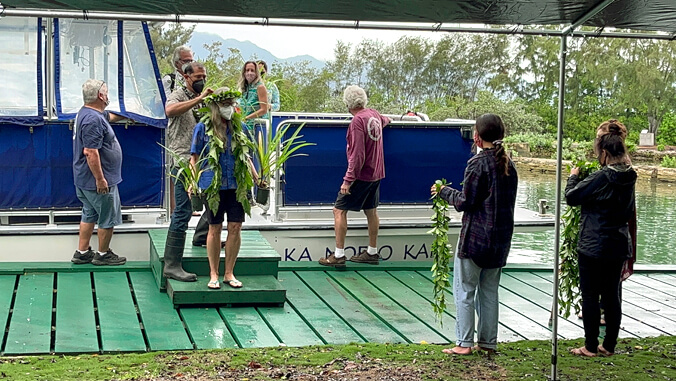
On the tranquil shores of Moku o Loʻe (Coconut Island) in Kāneʻohe Bay, Eleanor Sterling, the newly appointed director of the University of Hawaiʻi at Mānoa Hawaiʻi Institute of Marine Biology (HIMB) in the School of Ocean and Earth Science and Technology was officially welcomed into her new role. The January 3 ceremony incorporated symbolic Hawaiian protocol carefully selected as a way to pay homage to the people, traditional moʻolelo (stories) and lineage of the ahupuaʻa (land division) of Heʻeia where HIMB’s 28-acre island research facility is located.
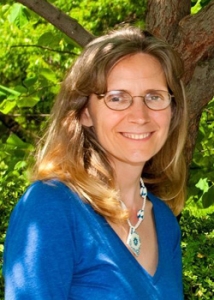
- Related UH News story: Eleanor Sterling appointed as director of Hawaiʻi Institute of Marine Biology, August 19, 2021
“One of the central intentions of the ceremony was to re-establish this place as a Native Hawaiian place of learning,” said Kawika Winter, associate professor of ʻāina sciences and reserve manager at Heʻeia National Estuarine Research Reserve. “Part of doing that is honoring the place names and the associated histories of said place.”
It is a vision fully embraced by Sterling, an internationally renowned scholar in biocultural diversity, conservation policy and resource management. Her recent studies have focused on culturally-attuned indicators of human and environmental health and well-being on Pacific Islands, including Hawaiʻi.
“There are already so many wonderful initiatives underway at HIMB,” Sterling said. “I think one way I can contribute is to help shine a greater light on them, to share the stories even more broadly so others understand the importance of the work at HIMB and its contributions to making Hawaiʻi and the world a better place. I am passionate about creating spaces for creative interchange, for transdisciplinary thought, for artists to work in concert with scientists to break down confining assumptions and re-envision how we think, know and act.”
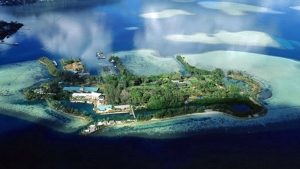
At the start of the ceremony, Sterling hit the ground running before stepping foot onto Moku o Loʻe. From the deck of a boat, she and her husband, Kevin Frey, engaged in traditional protocol, presenting an oli (chant) to kūpuna from Heʻeia and about 40 HIMB staff, faculty and students as a way to ask permission to disembark. The oli was written specifically for the occasion and filled with images that came to Sterling’s husband in a dream. Winter helped compose it, intertwining odes to elements of nature that nourish Moku o Loʻe and interconnect the island to its ahupuaʻa.
Excerpt from oli, Nolu pē Heʻeia
Nolu pē Heʻeia i ke onaona ʻiliahi
The sweet fragrance of the sandalwood rests upon Heʻeia
Māpu ke ʻala i ke Koʻolau
The scent wafts to the summit of the Koʻolau
Puīa ka ua i ke onaona
There the rain is infused with its scent
“I was at first nervous because chanting oli is not just about memorizing some phrases and ensuring you say the right word at the right time,” Sterling said. “Oli learners can spend months exploring each word or turn of phrase to choose which of the many, many possible meanings make sense to them. That richness of the Hawaiian language is at once exhilarating and daunting. My husband Kevin and I ended up having about a week to get to know this beautiful oli. We knew that people would be forgiving if we stumbled as we chanted but we wanted nothing to distract from honoring this place and people. This oli honors connections within and across the Heʻeia ahupuaʻa, its lands, seas and people.”
Respected Native Hawaiian cultural practitioner and Windward Community College lecturer Kumu Kawaikapuokalani Frank Hewett and Kupuna Leialoha “Rocky” Kaluhiwa welcomed Sterling onto the island with an oli on behalf of the community. Their ʻohana (family) are deeply rooted and tied to the Heʻeia ahupuaʻa.
ʻAuamo (working together)
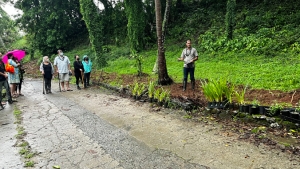
Participants were asked to join Sterling in the outplanting of ʻiliahi-a-Loʻe, a native coastal sandalwood tree thought to have once populated the island. Organizers said the intent behind it was not only to return the plant to its native home, but also to mark a new era of HIMB where everyone comes together with a common goal.
“HIMB’s commitment to grounding and centering its program in Indigenous knowledge is a great illustration of the direction UH Mānoa has committed to moving towards,” said Kaiwipunikauikawēkiu Lipe, UH Mānoa Native Hawaiian affairs program officer. “Our campus continues to strive to become a Native Hawaiian place of learning with the goal of manifesting more efforts like this throughout our curriculum, courses and colleges on campus.”
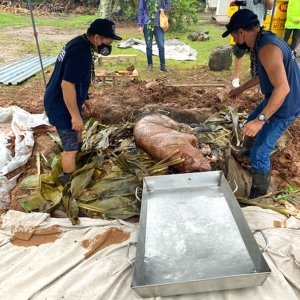
The ceremony concluded with a meal prepared by the Kaluhiwa and Domingo ʻohana whose connection to the ahupuaʻa of Heʻeia traces back more than 30 generations. Organizers asked if they would provide mea ʻai (food) to symbolize that HIMB’s work on the island cannot exist without the generosity of the community.
The HIMB is a world leader in multi-disciplinary research and education in all aspects of marine sciences.
More on Sterling
Building on her interdisciplinary training and more than 30 years of field research and community collaboration experience in Oceania, Africa, Asia and Latin America, Sterling’s work focuses on systems approaches to conservation and natural resource management; food systems; the intersection between biodiversity, culture and languages; the factors influencing ecological and social resilience; and the development of indicators of multidimensional well-being.

